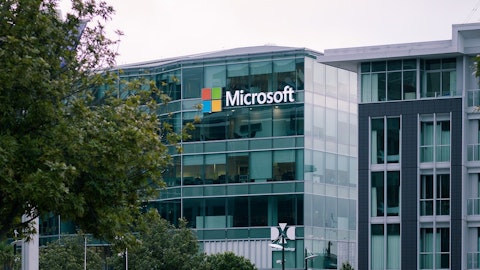Liz Coddington: Well, but let’s talk a little bit about churn. So our churn flat quarter-over-quarter, and we’re very pleased with our Connected Fitness potential levels overall. FaaS has a very minimal impact on overall churn at this point. And right now, we don’t expect any significant changes to our current churn levels aside from the fact that we do have small seasonal variations from quarter-to-quarter. So that’s a little bit about churn. Ron, I think there was a part of your question that was asking about how like 3P FaaS and refurbished program flow through our P&L, and I can give a little bit of perspective on that. Barry already gave some. So the fact that FaaS is becoming a bigger growth driver for us. Means that we do get less revenue from a new FaaS number than we do from somebody who buys a connected fitness hardware product because they just pay for the $150 delivery fee and then the cost of their membership.
That also impacts our gross margin in the month that they become a fast member. And we’ve talked about that before. So that is a near-term drag on margin. It’s also a near-term drag on revenue, just as — but over time, we recoup that. For 3P, we’ve talked about that as well that because our third parties do extract a margin from us, there is a little bit of an impact to revenue from them. We also have terms in accruals. We also consider our marketing expense as a contra revenue adjustment for those relationships. So those are a drag on revenue as well and a bit of a drag on gross margin, too. And then for refurb, because it is a lower price point, obviously, we’re getting less revenue from when we sell a refurbished spike. But on a cash margin perspective, it’s great because we are getting cash for products that we would have otherwise just had as a return and not been able to do something with.
So it’s great overall economics, although from a P&L standpoint, you will see the negative impact from that.
Ron Josey: Thank you, Barry, thank you, Liz. Very helpful.
Operator: Thank you. Our next question comes from the line of Brian Nagel with Oppenheimer. Your line is now open.
Brian Nagel: Hi, good morning. Thanks for taking my question. So maybe a couple of questions. Maybe unrelated, I’ll show into one to just make it simple. So first off, with regard to the now expanded distribution infrastructure with Amazon and Dick’s. Any additional insights there is how you may further develop that infrastructure? And then my second question, I know we’ve talked about FaaS a bit here, but as you look at the initial growth there, are you basically just allowing that growth to be dictated by the market, or are there governors in place right now that you could adjust over time to drive that growth one way or the other?
Barry McCarthy: If you mean drive the growth up or down?
Brian Nagel: Correct.
Barry McCarthy: Well, the answer to that is yes. Let’s say that we are concerned about the cash flow, the tax on cash flow, we just slow it down. We could hear — let’s say 300 units a day and decide we’re not selling anymore in a particular day, and we just take it down from the web so that can’t order any more parts in any particular day or week or month or quarter, by way of example. Secondly, it’s right for international expansion. The pace at which we decide to go is another lever. A third lever is, why don’t we just change the value proposition and we make it more expensive. That is churn implications, of course, which has lifetime value implications and CAC implications but it’s absolutely one of the variables that we factor into the mix and deciding how to modulate growth or we can lower prices and almost certainly grow faster as a consequence.
Liz Coddington: The only thing to add, the first part of the question, I think, was around any insights on developing our infrastructure with Amazon and Dick’s as third parties. I think right now, if you look at these partnerships, it’s still very new to us. We’ve only been roughly a quarter in terms of our relationship with Dick’s. We just went through our first holiday season with our third parties. And so while our third-party sales, along with the rest of our sales outperformed our expectations during holiday. We’re still learning about those partnerships and figuring out how we want to continue to partner to make it a win for both our business as well as Amazon and Dick. Do you want to add anything to that?
Barry McCarthy: No.
Operator: Our next question comes from the line of Youssef Squali with Truist. Your line is now open.
Youssef Squali: Great. Thank you. Two questions for me. First, can you maybe speak to the level of promotional intensity in the quarter and your plans and expectations for the second half? In other words, kind of what does the guide imply in terms of promotional activity? And two, maybe just a clarification, Liz, on something you said earlier about the seasonality you’re seeing this year similar to what you saw in 2022. In 2022, Q4, your fiscal Q4 was the lowest revenue quarter at about 19% of revenue. So I’m assuming that’s kind of what you’re telegraphing but what else you’d like us to know about how maybe Q4 will turn out. I know you’re not guiding yet. So maybe just directionally. Thank you.
Liz Coddington: So with regard to revenue, that second part of your question, we are not providing guidance on Q4. So I think you can interpret my comment earlier about revenue seasonality, how you want, but we’re not providing specific guidance on the quarter. On promotional intensity, and Barry, you can sell in for us anything I miss here. But I think the wish that we think about promotional levers, we have to come back to the whole concept of LTV to CAC and that promo is part of one of the key levers in that equation. So as we look in the quarter, we are going to make trade-offs between our media spending, our financing offers and also promotion as an opportunity. And especially as we have a lot of inventory right now, it is a lever for us.
And so we don’t comment too much about promotional strategy that’s for competitive reasons, in part, but we are trying to balance across our inventory reductions, managing margin and cash flow. All of those are important parts about how we think about promotional activity.





